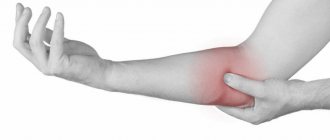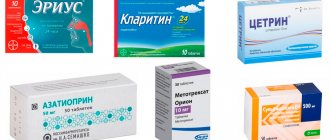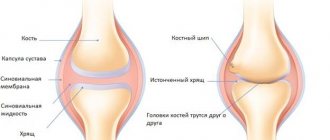In addition, the appearance of edema may indicate the presence of fungal or infectious diseases. When blood flow in the lower extremities is disrupted, blood begins to accumulate, which leads to swelling of the toe and its pain. Sometimes such problems can arise due to an ingrown toenail, but then the entire foot begins to swell along with the toes. Only the attending physician can eradicate the source of the disease. By removing part of the ingrown toenail, the symptoms will immediately disappear.
The presence of a splinter or thorn in a finger can also cause your toes to swell and hurt. After all, the infectious process can begin when a foreign body enters the finger. First of all, you need to figure out what caused the swelling of your fingers and begin to immediately take measures to eliminate them.
What diseases cause swelling in the toes?
Various types of diseases can also cause pain and swelling. These include pathologies such as:
1. Arthritis. An increase in size and limited mobility of one or more fingers may indicate the appearance of this disease, which causes degenerative disorders in cartilage tissue. The development of arthritis is provoked by the presence of excess weight in people, flat feet, and heavy physical work. It is not surprising that athletes often have swollen lower limbs, as they regularly receive injuries, bruises and sprains. At the second stage of development of the pathology, damage to the joints of the fingers occurs, so any delay entails great consequences. Without proper treatment, the patient's condition will worsen, ultimately leading to disability. You should immediately consult a doctor and undergo a full physical examination if you experience swelling and pain in your big toe.
2. Arthrosis. One of the most common symptoms of this disease is swelling of the toe near the nail. This joint pathology is characterized by a destructive effect on cartilage. At the beginning of the disease, the pain is periodic, but eventually becomes chronic. Osteoarthritis often begins with pain in the big toe, which disappears with rest. In the morning, patients experience a certain degree of stiffness, difficult functioning of the joints, as well as a crunching sensation. Signs of arthrosis such as limited mobility and chronic pain overlap with the symptoms of subchondral sclerosis and epicondylitis. If an infection appears in the joints, then arthrosis becomes infectious.
3. Osteoporosis. With the development of this disease, bones lose strength and mass, which is due to pathological processes that make bone tissue fragile and cause swelling. Patients with osteoporosis should treat their fingers carefully and with caution, because any careless movement can lead to a fracture. At the beginning of the development of the pathology, the toe swells and begins to hurt, and after a while deformation occurs with the foot.
4. Symptoms when the joint of the big toe is swollen and painful, and also red, may indicate the development of a disease such as bursitis. Severe bruises and advanced stages of arthrosis can cause its appearance. When a joint is affected, the space between the bones and muscles becomes inflamed and filled with fluid. If the pathology is not treated, the disease becomes chronic and the pain becomes permanent. To confirm the diagnosis, the patient undergoes a fluid tap, MRI, and x-ray in addition to a visual examination.
5. The development of gout can be caused by a malfunction of metabolic processes in the body. This pathology is more common among men than women. At the initial stage of the pathology, the toes swell, and later the phalanges of the fingers can completely collapse. Swelling and pain are paroxysmal in nature
6. Ankle injury. When there is a lot of stress on the legs, the most vulnerable place is the little toe. For example, it can be damaged by hitting a furniture leg or door frame, or by wearing tight shoes. After the blow, the little finger begins to swell and hurt. In general, bruises do not pose any danger to humans. However, the negative impact can manifest itself in the form of chronic pain or the development of not the most pleasant diseases. If after the blow the finger is swollen and painful, then it is necessary to undergo a medical examination.
7. Swelling of the fingers can also be caused by an allergic reaction. If the legs are constantly itching, itching and discomfort appears, then the human immune system begins to react to irritating factors and produce chemicals that cause swelling. All symptoms will go away only if the external irritant is neutralized.
8. Diabetes mellitus. Swelling of the legs in this disease is provoked by metabolic disorders. Typically, patients experience pain and blue toes. In addition, the sensitivity of the lower extremities decreases, there is numbness in the fingers and a burning sensation in the feet. If such symptoms are observed, you should immediately contact an endocrinologist so that the doctor can conduct an examination and prescribe the most appropriate treatment.
9. Panaritium. This pathology appears due to infectious infection. The symptoms are clearly visible, which begin with suppuration of the nail, are characterized by pain and swelling of the finger, and cysts with purulent contents form. A blister and swelling may be seen on the phalanx. In addition, sensitivity disturbances and capillary blockage occur. In this case, herbal baths can help, but the disease can be completely cured only after opening the cysts and completely removing the purulent contents.
Diagnostics
Diagnosis of diseases accompanied by pain in the toes is carried out by orthopedic traumatologists. If necessary, rheumatologists, surgeons, dermatologists, and other specialists are involved in the examination. The examination plan includes:
- Survey.
The doctor finds out the time and circumstances of the appearance of pain and other signs, establishes the connection of pain with external circumstances, studies life history, family history. - Physical examination.
During the examination, the specialist evaluates the appearance of the foot and fingers, determines the presence of deformities, swelling, local hyperthermia, and discoloration of the skin. Examines range of motion, sensitivity, pulsation of arteries. - X-ray of the toes.
Visualizes dislocations, fractures, areas of restructuring or destruction of bones and joints, degenerative and inflammatory changes. - Dermatoscopy.
It is carried out to differentiate callus and onychogryphosis from other diseases, to exclude the mycotic or viral nature of the lesion. According to indications, it is supplemented with other dermatological techniques. - Ultrasound.
Performed for vascular diseases. Duplex scanning and ultrasound scanning allow us to study the condition and patency of the arteries, and the speed of blood flow. - Laboratory research
. Recommended for confirming inflammatory processes, detecting markers of rheumatic diseases, and studying flora.
Examination by a traumatologist-orthopedist
Which doctor should I contact?
To determine the reason why your toe hurts and is swollen, as well as to treat this problem, you need to consult a doctor. The first step is to visit a therapist, who can prescribe treatment or refer you to a more highly qualified specialist. Swelling of the extremities can also be caused by heart disease, therefore, to exclude this cause, the patient should be examined by a surgeon or rheumatologist. An orthopedist will help solve the problem of foot deformities, and an endocrinologist will prescribe treatment for hormonal imbalances. If the condition is the result of an injury, then you should visit a traumatologist who will identify the essence of the problem. An accurate diagnosis and treatment are possible only after studying the symptoms of the disease and analyzing the patient’s condition.
Before a consultation with a doctor is scheduled, you can relieve the pain on your own. To prevent your toes from hurting, you can apply heat or cold to them (when they burn and turn red). At home, you can use both medications and traditional medicine.
Treatment
Help before diagnosis
For injuries, elevate the foot and apply an ice pack or a heating pad with cold water. Fractures are fixed with a splint or a special bandage. Patients with frostbite are treated with insulating bandages. For non-traumatic lesions, the leg is given rest, and local anesthetics and anti-inflammatory drugs are sometimes used.
Conservative therapy
Dislocations are reduced; in case of displaced fractures, reposition is performed and immobilization is carried out. For pain in the fingers, the following conservative measures can be used:
- Protective mode
. The patient is recommended to limit the load on the limb, use orthopedic products or special devices (cane, crutches). - Drug therapy
. For inflammatory and degenerative processes, NSAIDs are prescribed. Infectious diseases are an indication for antibiotic therapy. For vascular diseases, drugs to improve blood circulation are effective. - Non-drug methods
. UHF, medicinal electrophoresis, magnetic therapy, and other physiotherapeutic techniques may be indicated. Some patients are recommended exercise therapy and massage.
How to prevent the disease
Basic preventive measures help prevent swelling in the toes. You just need to take care of your body and try to avoid the possibility of injury. The key to good foot health will be personal hygiene, which should be present in every person's life on an ongoing basis.
Particular attention should be paid to the choice of comfortable, high-quality shoes, which should be made from natural materials, and also have a not very high heel and a comfortable sole. In addition, you can use special orthopedic shoes or insoles. If fungal or other diseases are detected, treatment should be started immediately.
You should also monitor your diet so that it is complete and includes all the necessary microelements obtained from foods. It is necessary to reduce the amount of salt consumed, as it prevents excess water from leaving the body, which causes edema. It is also better to abstain from drinking alcohol or reduce it to a minimum.
Swelling of the fingers is easy to treat and is often completely eliminated, but only if treatment was provided in a timely manner. By following basic rules, you can prevent the formation of edema and also maintain your health.
Arthrosis of the toe joints - what is it?
Osteoarthritis of the interphalangeal and metatarsal joints of the legs is a chronic degenerative disease that begins with the destruction of cartilage tissue and can disfigure the patient’s fingers and feet beyond recognition. Regardless of the causes of this condition, it leads to complete degeneration of cartilage and its replacement by bone growths - osteophytes.
Since the foot and toes - the load-bearing supports of the human body - are subject to enormous stress, arthrosis of the toes is extremely common. According to some estimates, it affects up to 10% of the human population over 60 years of age. It’s not surprising, because the foot doesn’t rest even when we sit!
Typically, the disease begins in the big toe or little toe and primarily affects the metatarsophalangeal joint. Osteoarthritis of the second or third finger is less common. In recent years, there has been a trend towards “rejuvenation” of the disease - arthrosis of the big toe is increasingly found in patients aged 30-35 years.
Treatment of arthrosis of the toes
Based on the tests performed, the observing doctor draws up an individual treatment strategy, which depends on the stage of the disease, the presence of concomitant health problems, age, weight, lifestyle and anatomical characteristics of the patient. The general course of treatment for arthrosis of the toe joints may include taking chondroprotectors and vitamin-mineral complexes, diet adjustments, therapeutic exercises, and teaching the patient an orthopedic regimen. At stages 2 and 3, the use of nonsteroidal anti-inflammatory drugs (NSAIDs), painkillers, hormonal corticosteroid injections, and physical therapy is indicated. If a joint completely loses its functions, endoprosthetics (usually of the metatarsophalangeal joints) may be prescribed.
At the 1st stage of arthrosis of the joint of the big toe, complete recovery is still possible - the main thing is to consult a doctor in time. At the 3rd stage, as a rule, surgical intervention is indicated - without it, the patient’s quality of life and level of activity drop significantly, and unremitting pain leads to sleep disturbances and decreased mood.
For successful treatment of arthrosis of the toe joints, it is important to follow three principles:
- Seeing a doctor earlier increases the chances of recovery or stable remission.
- Treatment is carried out continuously, over a long period of time.
- Outpatient therapy occurs with regular consultations with the attending physician. Don't self-medicate!
Treatment of arthrosis of the toes with medications
For moderate symptoms, in the drug treatment of arthrosis of the toes, preference is given to local NSAIDs in the form of ointments, creams, and gels. In advanced cases with severe pain, anti-inflammatory drugs together with analgesics can be injected directly into the diseased joint. For systemic joint damage or as part of complex therapy, NSAIDs are also prescribed in the form of tablets or intramuscular injections. This allows you to quickly relieve swelling, improve nutrition of the tissues around the joint, and facilitate warm-up. In addition to relieving symptoms and treating toe joints, the use of any non-steroidal anti-inflammatory drugs slows down cartilage degeneration.
Ointments in the treatment of arthrosis of the toes with medications can be used daily. Short courses of NSAIDs in tablets aimed at relieving an acute inflammatory process are prescribed by a doctor. If taken for a long time, they can lead to stomach ulcers.
If more serious therapy is required to relieve inflammation, the doctor may prescribe hormonal injections with glucocorticosteroids (their use on their own is extremely dangerous!). Analgesics (systemic or local) are used to relieve pain and are selected taking into account its intensity. The main treatment for arthrosis of the big toe is usually supplemented with vasodilators, which improve the nutrition of periarticular tissues and serve to prevent foot diseases (for example, fungal).
It is also recommended to take lifelong dietary supplements based on cartilage tissue components - glucosamine and chondroitin (for at least 3-6 months a year). Effective at stages 1 and 2.
Causes of arthrosis of the toes
Joint diseases, incl. arthrosis of the joints of the toes must be considered comprehensively - often the prerequisites and triggers of the disease include several factors at once. These factors lead to disruption of phosphorus-calcium metabolism, starvation of cartilage tissue, and its loosening.
Common causes of osteoarthritis of the toes include:
- injuries to the fingers, foot or joints located above (frequent and severe bruises of the little finger, left without treatment, can also provoke arthrosis);
- congenital abnormalities of the foot, postural disorders (flat feet, club feet, lordosis, kyphosis, etc.);
- wearing uncomfortable shoes (tight, constricting, not warm enough, worn out or high-heeled, or otherwise leading to an unphysiological position of the foot);
- hypothermia (local or general);
- excessive load on the legs (“standing” profession, excess weight, active sports, habit of uncomfortable posture);
- diseases of the peripheral arteries of the lower extremities (varicose veins, thrombosis and others);
- metabolic disorders (diabetes mellitus);
- endocrine diseases, hormonal imbalances, menopause or pregnancy;
- the presence of infectious agents in the body;
- genetic predisposition associated with the density of cartilage tissue, metabolic characteristics, and the anatomical structure of the limbs;
- the presence of arthritis and arthrosis of other joints, especially with systemic diseases;
- smoking and other bad habits;
- stress - physical, mental or emotional stress;
- elderly age.
The exact causes can only be determined after a series of tests, x-rays, and in some cases, an MRI. Acute inflammation in arthrosis of the toes usually occurs after active physical activity, and also if particles of osteophytes break off and enter the joint capsule, injuring it during movement.
WHEN YOU SHOULD SOUND THE ALARM, THE FIRST SYMPTOMS OF felon
There are two forms of the disease:
- Purulent form;
- Serous form, in which swelling is more pronounced.
The panaritium of the finger is formed at the site of a microtrauma that has become infected. Swelling, hyperemia and painful sensations of a pulsating nature appear. Symptoms of general malaise and fever may also develop.
Tendon panaritium.
With articular and bone panaritium, the joint and bone of the phalanx of the finger are involved in the purulent process. The symptoms of bone and articular felon are similar to those of subcutaneous felon, but more pronounced. The swelling usually spreads throughout the finger. The pain is strong, intense and cannot be clearly localized, the finger is bent, movements are impossible due to pain and swelling. Spontaneous breakthrough of pus through the skin with the formation of purulent fistulas is possible. In the case of articular panaritium, swelling, redness and pain are initially localized around the affected joint, but if left untreated, they spread to the entire finger.
A typical clinical picture is shown in the photo.
Surgical treatment of paronychia
There are two phases of the inflammatory process - serous-infiltrative and purulent. Since the first period is very short, surgeons usually encounter a purulent clinical-anatomical form of paronychia. The inflammatory process in superficial paronychia is localized in the thickness of the fold of the periungual fold. If an abscess forms under the fold of the periungual fold closer to the edge of the base of the nail plate, then we are talking about deep paronychia. In this case, the pus moves under the exfoliated part of the nail plate, that is, paronychia is complicated by subungual panaritium. During natural development, the purulent focus can spontaneously open outward at the lateral periungual fold.
Surgical treatment of paronychia is carried out in the presence of purulent inflammation. Opening the abscess is performed under local anesthesia. If suppuration is localized under the nail plate, part of the nail is removed. In case of detachment of the nail plate, it is completely removed. The wound is drained, treated with an antiseptic, and a bandage is applied. Dressings are carried out daily until the wound heals.
Related services: Surgery
Paronychia of the finger: treatment
Treatment of acute paronychia without pus is carried out using conservative methods. For chronic paronychia, antimycotic (antifungal) agents are indicated. If local therapy is ineffective, oral antifungal agents are prescribed.
Paronychia of the finger on the hand - treatment:
- rest of the finger;
- wet compresses;
- warm baths;
- physiotherapeutic procedures;
- Antibacterial therapy (usually broad-spectrum antibiotics or fluoroquinolones).
If, with paronychia of the finger, treatment with conservative methods does not produce results and the inflammatory process has passed into the purulent stage, then the abscess is opened and drained.
Prevention of paronychia:
- hands and feet should be dry and clean;
- If your hands are regularly exposed to water or harsh chemicals, you should use rubber gloves lined with absorbent cotton fabric;
- It is necessary to carefully treat the nail and the tissue around it during manicure and pedicure;
- It is advisable to avoid traumatic cuticle removal. It is better to use emollients and gently move it;
- you should get rid of the habit of biting your nails and the skin around them;
- If you have diabetes, monitor your blood sugar levels.
Read more about the prevention of paronychia and felon on our website https://www.dobrobut.com/.









